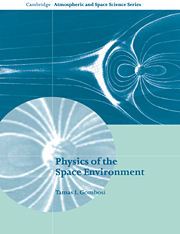Book contents
- Frontmatter
- Contents
- Preface
- Part I Theoretical Description of Gases and Plasmas
- Chapter 1 Particle Orbit Theory
- Chapter 2 Kinetic Theory
- Chapter 3 Basic Plasma Phenomena
- Chapter 4 Fluid and MHD Theory
- Chapter 5 Waves and Oscillations
- Chapter 6 Shocks and Discontinuities
- Chapter 7 Transport of Superthermal Particles
- Part II The Upper Atmosphere
- Part III Sun—Earth Connection
- Appendices
- Bibliography
- Index
Chapter 7 - Transport of Superthermal Particles
Published online by Cambridge University Press: 22 October 2009
- Frontmatter
- Contents
- Preface
- Part I Theoretical Description of Gases and Plasmas
- Chapter 1 Particle Orbit Theory
- Chapter 2 Kinetic Theory
- Chapter 3 Basic Plasma Phenomena
- Chapter 4 Fluid and MHD Theory
- Chapter 5 Waves and Oscillations
- Chapter 6 Shocks and Discontinuities
- Chapter 7 Transport of Superthermal Particles
- Part II The Upper Atmosphere
- Part III Sun—Earth Connection
- Appendices
- Bibliography
- Index
Summary
In this chapter we will briefly consider some of the basic theoretical tools used in describing the transport of superthermal particles. By superthermal particles we mean a very small fraction of the total particle population with energies far exceeding the average thermal energy. These superthermal particles contribute negligibly to the particle density and bulk velocity (due to their very small number compared to the total number of particles), but in some cases they may represent a significant contribution to the pressure and heat flow.
We will consider the basic transport equations describing two kinds of superthermal particles: energetic solar particles and photoelectrons. Since our goal is to provide an introduction to the theoretical tools of space physics, we will constrain our derivations to the most fundamental processes. More sophisticated treatments can be found in the literature.
Transport of Energetic Particles
As in most cases, we start from the Boltzmann equation describing the evolution of the particle distribution function. The main difference this time is that because superthermal particles can be relativistic, we need to derive a transport equation that is valid for relativistic particles as well. To achieve this we use the form of the Boltzmann equation given by Eq. (2.36), where the variables of the distribution function are time, location, and full (inertial) velocity.
- Type
- Chapter
- Information
- Physics of the Space Environment , pp. 113 - 122Publisher: Cambridge University PressPrint publication year: 1998



